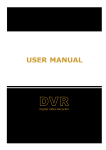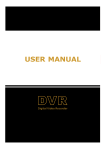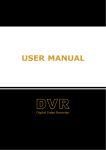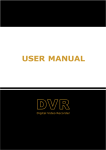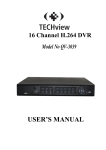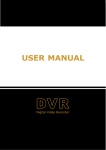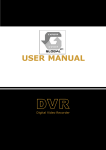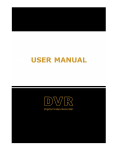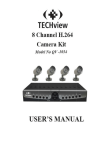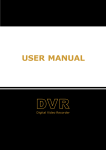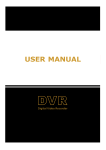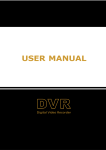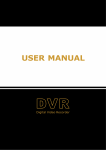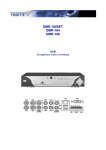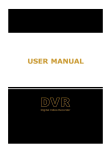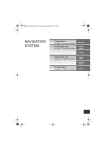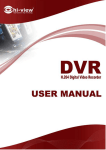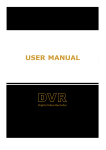Download Manual - Northern Tool + Equipment
Transcript
1 User Manual CONTENTS SAFETY INSTRUCTION .................................................................................................................................................... 1 CHAPTER 1: DVR FEATURES ......................................................................................................................................... 2 CHAPTER 2: LAYOUT ....................................................................................................................................................... 3 2.1 FRONT PANEL (ONLY FOR REFERENCE) ........................................................................................................................... 3 2.2 SIDE PANEL(ONLY FOR REFERENCE) ............................................................................................................................... 3 2.3 REAR PANEL(ONLY FOR REFERENCE).............................................................................................................................. 4 2.4 REMOTE CONTROL ........................................................................................................................................................ 5 CHAPTER3 CONNECTING DVR ...................................................................................................................................... 7 3.1 HDD INSTALLATION...................................................................................................................................................... 7 3.2 CAMERA AND MONITOR CONNECTION ........................................................................................................................... 7 3.3 POWER SUPPLY CONNECTION ........................................................................................................................................ 7 CHAPTER 4: DVR BOOT UP ............................................................................................................................................ 8 4.1 SYSTEM INITIALIZATION ................................................................................................................................................ 8 4.2 MAIN INTERFACE .......................................................................................................................................................... 8 CHAPTER 5 DVR MENU ................................................................................................................................................... 8 5.1 CONTEXT-SENSITIVE MENU ........................................................................................................................................... 8 5.2 MAIN MENU PREVIEW ................................................................................................................................................... 9 5.3 MAIN MENU ............................................................................................................................................................... 10 5.3.1 Camera Set ...................................................................................................................................................... 10 5.3.2 Record Set........................................................................................................................................................ 10 5.3.3 Network Setup...................................................................................................................................................11 5.3.4 Video Search.................................................................................................................................................... 13 5.3.5 Device Management ........................................................................................................................................ 15 5.3.5.1 HDD Manage ..................................................................................................................................................................16 5.3.5.2 Alarm Set.........................................................................................................................................................................16 5.3.5.3 PTZ Set..........................................................................................................................................................................19 5.3.5.4 Mobile Monitoring.........................................................................................................................................................19 5.3.5.5 Motion Detection ..........................................................................................................................................................19 5.3.5.6 Serial Port Set ..............................................................................................................................................................20 5.3.6 System Set ....................................................................................................................................................... 20 5.3.6.1 Time Set ..........................................................................................................................................................................20 5.3.6.2 Password .........................................................................................................................................................................20 5.3.6.3 Audio/Video Set...............................................................................................................................................................21 1 User Manual 5.3.6.4 Language.........................................................................................................................................................................21 5.3.6.5 System Information..........................................................................................................................................................21 5.3.6.6 System Maintenance .......................................................................................................................................................21 5.4 MENU LOCK................................................................................................................................................................ 22 5.5 SPLIT MODE ................................................................................................................................................................ 22 5.6 PTZ CONTROL ............................................................................................................................................................ 22 5.7 PIP MODE ................................................................................................................................................................. 23 5.8 VIDEO SEARCH............................................................................................................................................................ 23 5.9 MUTE ......................................................................................................................................................................... 23 5.10 RECORD .................................................................................................................................................................... 24 5.11 STOP RECORD............................................................................................................................................................ 24 5.12 START SEQUENCE ...................................................................................................................................................... 24 5.13 START CRUISE ........................................................................................................................................................... 24 CHAPTER 6: WEB APPLICATION MANAGER............................................................................................................. 24 6.1 PLUG-INS DOWNLOAD AND INSTALLATION .................................................................................................................... 24 6.2 WEB APPLICATION MANAGER LOG-IN .......................................................................................................................... 25 6.3 WEB APPLICATION MANAGER INTERFACE .................................................................................................................... 25 6.3.1 Menu toolbar....................................................................................................................................................... 25 6.3.1.1 Live Display ..................................................................................................................................................................25 6.3.1.2 Playback mode.............................................................................................................................................................25 6.3.1.3 Setup.............................................................................................................................................................................26 Record Mode......................................................................................................................................................................26 Alarm Set...........................................................................................................................................................................27 PTZ Control.......................................................................................................................................................................28 Network Set .......................................................................................................................................................................28 System Set .........................................................................................................................................................................28 Host Info............................................................................................................................................................................30 6.3.2 PTZ Control ........................................................................................................................................................ 30 6.3.3 Play Mode ........................................................................................................................................................... 30 CHAPTER 7: SPECIFICATIONS ..................................................................................................................................... 32 CHAPTER 8: APPENDIX ................................................................................................................................................. 33 8.1 OPERATION FUNCTION TABLE ...................................................................................................................................... 33 8.2 RECORD ALARM SETTING ............................................................................................................................................ 35 8.3 COMPATIBLE MOBILE LIST ............................................................................................................................................ 35 8.4 MAIL BOX SERVER LIST ............................................................................................................................................... 35 8.5 TROUBLESHOOTING ..................................................................................................................................................... 36 8.7 SYSTEM CONFIGURATION ............................................................................................................................................ 37 8.8 ACCESSORY................................................................................................................................................................. 37 2 User Manual Safety Instruction 1. Read Instruction All the safety and operating instruction should be read before the equipment is operated. 2. Power sources This equipment should be operated only from the type of power source indicated on the marking label. If you are not sure of the type of power, please consult your equipment dealer. 3. Objects and Liquid Never push objects of any kind through openings of this equipment and / or spill liquid of any kind on the equipment as they may touch dangerous voltage points or short out parts that could result in a fire or electric shock. 4. Water and / or Moisture Do not use this equipment near water or in contact with water. 5. Heat sources Do not install near any heat sources such as radiators, heat registers, stoves or other apparatus (including amplifier) that produce heat. 6. Cleaning Unplug this equipment from the wall outlet before cleaning it. Do not use liquid aerosol cleaners. Use a damp soft cloth for cleaning. 7. Lightning Unplug this equipment during lightning storm or when unused for long periods of time. 8. Accessories Do not place this equipment on an unstable cart, stand or table. When a cart is used, use caution when moving the cart / apparatus combination to avoid injury from tip-over. 9. Moving Disconnect the power before moving the equipment. And the equipment should be moved with care. 10. Attachment Never add any attachments and/or equipment without the approval of the manufacturer as such additions may result in the risk of fire, electric shock and other personal injury. 11. Correct Batteries Risk of explosion occurs if battery is replaced by an incorrect type. Therefore you must use the same type of battery as the one being used in the product. 12. Ventilation. Do not block any ventilation openings, installation of the equipment in the rack should be such that the amount of airflow required for safe operation of the equipment is not compromised. 13. Overloading Do not overload wall outlets and extension cords to avoid the risk of fire or electric shock. 14. Reliable Earthlings (Grounding) Reliable grounding of rack mounted equipment should be maintained. Particular attention should be given to supply connections other than direct connections to the branch circuit. 1 User Manual Chapter 1: DVR Features Function Brief and Description Real time monitoring Single video output; with monitor, VGA virtual output port; Support net-viewer and MP live surveillance, ZOOM IN/OUT, dwell time display and PIP display. Recording H.264 video compression format; recording quality optional, multiple recording modes (Always, Scheduled, Manual, Alarm, Motion detection and remote recording.) Save Recordings Support SATA large capacity HDD and save real-time recording image to HDD. Playback Recordings Supports DVR single CH and multiple CH playback of recorded files Backup Recordings Supports DVR backup via USB flash drive, removable drive, Recorder and network. Alarm Setting Supports HDD & video input alarm management and external alarm signal inputs Network operation Supports remote surveillance by multiple users simultaneously. Mouse Operation Supports Mouse operation for faster menu navigation. PTZ Control Supports PTZ camera operations through RS-485. List 1-1 Other Features: H. 264 video compression format; supports D1/HD1/CIF resolution; ADPCM audio compression format Windows Graphical interface; built-in real-time Linux2.6 operation system. Friendly Menu reminder. Multiple operation (Preview, recording, playback, backup, network surveillance and mobile phone monitoring at the same time) Supports Double Encode bit network transmission Supports remote live viewing via 3G mobile networks Supports zoom in / out and dwell time display The video package time is adjustable Multiple alarm record mode Rear USB2.0 ports for back-up, upgrade and mouse operation. With IR remote control operation Multiple language OSD Supports auto maintenance 2 User Manual Chapter 2: Layout 2.1 Front Panel (Only for reference) Item 1 2 Type Key title /Indicator Marks HDD indicator HDD Power indicator PWR Indicator IR Receiver Function When the “Red” indicator flashes it means the hard drive is being read or written to. If the “Green” indicator is on the system is getting power normally Receive infrared remote control signal List 2-1 2.2 Side Panel(Only for reference) Function Item Marks 1 ON/OFF The button allows you open/close the screen. 2 MENU The button allows you adjust parameters and switch menu. 3 UP The buttons allow you change parameter values. 4 DOWN List 2-2 3 User Manual 2.3 Rear Panel(Only for reference) Item Physical port Connection method 1 Power Switch Turn Power On And Off 2 USB Port Connect USB device (Flash Drive, Hard Drive and Recorder) 3 Mouse Port Connect USB mouse 4 DB-16 1~16 Video Output 5 VGA Port Connect To VGA Monitor,Such As PC Monitor 6 DB-7 DB-7 Jacket 7 LAN Port LAN Input 8 RS-485/Sensor/Alar m RS485/Sensor/Alarm below) Power Port Connect Power Supply –DC 12V 6A 9 interface (see pin outs RS485/Sensor/Alarm port functions: Alarm input: Connect [-] port of your sensor to G (GND) pin, and [+] port to channel input you want to set. Alarm output: indicate the two ports marked “out”. PTZ Port:Connect your camera to RS-485A and RS485B accordingly. 4 User Manual 2.4 Remote Control Key Title Key Function REC Manual recording SEARCH Enter into recording search menu 2×2 Quad display 3×3 9-CH display 4×4 16-CH display AUTO Dwell time display 0~9 Channel select; numeric key DISPLAY MODE Multiple CH display (Quad, 9-CH, 16-CH and single channel ) display ▲ UP ▼ DOWN ◄/ Left/right key ENTER Select / Edit key; Enter key Menu/ESC Enter into main menu / Exit PIP PIP display mode MUTE Mute key FWD Forward REW Rewind PLAY Enter into recording search, play recording event STOP Manual stopping play PAUSE/ FRAME Pause / play frame by frame SLOW (1/2、1/4、1/8)Slow play Z+ Zoom out video area Z- Zoom in video area (x2、 x4、x8) (x2、x4、x8) F+ Extend focus F- Extend focus I+ Add PTZ brightness I- Decrease PTZ brightness PTZ Allow you set presetting bit and control PTZ. LOCK Lock system List 2-4 5 User Manual Mouse Operation You can also perform system operation by using a mouse except for Front panel and Remote Controller. TYPE Function In menu lock mode, Enter into pop-up menu and clicking any sub menu to pop up Log-in window; on menu unlock mode, enter into pop-up menu, and then clicking left key to enter into any sub menu directly. After entering main menu, clicking left key could enter into any sub menu; On[Detailed file] menu mode, clicking left key could playback one recording file. Click left key Change the status of check box and motion detection area. of Mouse Clicking combo box to access pull-down menu; Click left key to stop dwell time display when dwell time display is “ON” By clicking left key you can adjust Color control bar and volume control bar. Clicking combo box to access pull-down menu By clicking left key you can select values in edit boxes or pull-down menu and supports Chinese word input, special symbol, numeric and character input, use instead of [Enter] or [Backspace ] Click right key of Mouse Double-click Left key of Mouse In live display mode, clicking right key will display pop-up menu (shown as Picture 5-1). In Main menu or sub menu mode, clicking right key will exit current menu. In live display or playback mode, double-clicking left key will maximize the screen. Moving Mouse Select menu item Sliding Mouse On motion mode, sliding mouse will select motion area; On [Color set] menu mode, sliding mouse will adjust color control bar and volume control bar. List 2-5 6 User Manual Chapter3 Connecting DVR 3.1 HDD installation Caution: Please do not Install or take out hard drive when DVR is running! The model has a HDD drawer. Please use provided key to take out the HDD drawer and put HDD into the drawer correctly. Please follow the below steps to install the HDD: 1. Loosen the screw from upper cover and remove the upper cover and LCD on the power break mode; 2. Insert data cord and power cable into HDD securely; 3. Fix the HDD on the rack; 4. Put the upper cover and LCD back carefully, re-attach screws. 3.2 Camera and Monitor Connection Connect camera cable to video input of DVR, and from video output of DVR to Monitor via BNC connector (Refer to section2.3-Rear Panel); or If the camera is a PTZ speed dome, you could connect RS485 A & B to the according port of DVR respectively (refer to system figuration on Chapter 8). 3.3 3.3 Power Supply connection Please only use the power adapter supplied with the DVR. 7 User Manual Chapter 4: DVR Boot up 4.1 System Initialization Connect the power cable of DVR to power supply and press the [Power] button, you will see the initialization screen shown as Picture 4-1. Picture 4-1 4.2 Main Interface After finishing the initialization processing, system will enter into Main interface screen. Picture 4-2 is the 16-split main interface defaulted by system, which is showing no video input status. Once there are video inputs, the interface will display live images from the cameras. In main interface mode, if you double-click the live image of any channel, the image will be maximized to full screen, by double-clicking again, the display will be returned back to16-split mode. Picture 4-2 Clicking the right button of the mouse will pop up Context Sensitive Menu; by clicking the left button of the mouse, you can select menu items; when clicking any area outside the menu, you will exit the Context-Sensitive menu. Note: If DVR is not connected to Hard Driver, “H” Character will appear in the screen and buzzer will sound the alarm. To close the buzzer alarm, please enter into [Device manageAlarm Set] menu and set [HD Loss] alarm, [Not enough HD space] alarm and [Alarm output] to “Off”. Chapter 5 DVR Menu 5.1 Context-Sensitive Menu On the Main interface mode, right-clicking any area will pop up Context Sensitive Menu, now you can perform parameter settings for Main Menu, Screen Split mode, PTZ control, PIP, Search, Mute, Manual record, Stop record and Start Cruise etc. The Context Sensitive Menu appearing by right-clicking the screen differs depending on different parameter setting and application environment. Picture 5-1 8 User Manual 5.2 Main Menu Preview Color set Camera Dwell time display Recording Search Network Playback Rec. Search Detail File File Backup HDD Management Main Menu Email Setting Alarm Setting Device Management PTZ Setting MP monitoring Motion Area setting Time Setting User password Video Setting System Language Select System Information System Maintenance 9 User Manual 5.3 Main Menu In Main Interface mode, click right key of mouse to pop up Context Sensitive Menu, and then highlight and select [Main menu] item to enter into Main menu. Now user can freely set parameters for [Camera], [Record], [Network], [Search], [Device] and [System] as per user’s needs. Picture 5-2 5.3.1 Camera Set Click [Main MenuCamera] option to enter into the below interface shown as Picture 5-3. Picture 5-3 Picture 5-4 is the Color Menu where you can adjust image brightness, saturation, contrast and hue of each channel. Friendly Reminder: 1. The modifications will be available after clicking [APPLY] button on the bottom of the sub-menu windows and being prompted to save and then clicking [ok] button. 2. If you want to cancel the modification, click [Exit] button to exit the menu. 3. When clicking [DEFAULT] button, all system values will be Picture 5-4 reset to default value. 4. System default value indicates the value pre-set at the factory. 5.3.2 Record Set Click [Main MenuRecord Setup] option to enter into the interface shown as Picture 5-5. The [Record Setup] menu allows you set up recording status (on/off) of each channel, it also allows you setup recording image resolution and quality, and turns audio on/off Picture 5-5 Channel: allows you select your desired channel by clicking the pull-down menu. Record Enable: Once a channel is set to <On>, the video from the channel can be recorded, and set to <Off>, the video will not be recorded. Quality: Give you three options – Best, Good and Normal – to choose the quality of your recorded images. Resolution: Allow you select three levels –CIF, HD1 and D1. 10 User Manual Audio: When Audio is set to “On”, system will also record audio from the channels and will have audio output on playback mode; if it is set to “off” you can not record audio and will have no audio output available on playback mode. Rec. Mode: allow you select record mode (Always and scheduled record) Pack Time:allow you select pack time for recorded file(15, 30, 45 and 60 min) To record 24 hours a day set the [Rec Mode] to Always. To record on motion or on schedule, select the “Schedule” option from pull-down menu, you can find a new schedule open shown as Picture 5-6. It will include 24 columns from 0~23 each representing a house of the day and 7 rows for each day of the week. Each box represents an hour in the week. After entering into [Schedule] option, you can select your desired channel(s) (<All>, <CH1> to <CH16>) from the pull-down menu. To setup weekly schedules, tick-select the check-box of the recording status you want (Alarm, General, or No Record) and then click on each box in the schedule time line. Picture 5-6 You can use the [From – To] pull-down menus and Copy button to copy settings from one day to another day or all days. RED = ALARM GREEN = NORMAL WHITE = NO RECORD. 5.3.3 Network Setup Click [Main MenuNetwork] to enter into the left window and select network type (such as DHCP, PPPoE and Static) and s media port and web port as per user’s network environment. Now user can visit and operate her DVR remotely. DNS: Generally DNS is provided by local ISP. Herein input IP address of your domain name server. Picture 5-7 Friendly Reminder: 1. All the parameters you set are available only when you click [Apply] and after system are restarted. 2. User need to change MAC address when there are multiple DVRs at the same local area network. Details please refer to section 5.6.2.5 -System Information. When selecting DHCP form the Type, DHCP server will automatically allocate IP address for your DVR. The IP address of the DVR might change whenever the unit is turn on if the DVR is configured for DHCP. When selecting Static from the Type, user can directly input IP address, Subnet Mask, Gateway and DNS shown as below picture. 5-8 Picture 5-8 11 User Manual When selecting PPPoE form the Type, user can input user name and password provided by ISP and set Media and Web port. You can visit your DVR remotely via public network using the IP address captured after restart or register a domain name and web port to connect to your DVR. Picture 5-9 DDNS (Dynamic DNS) is a service that register a domain name and the floating IP address with the DDNS server so that the domain name can be routed to the IP address even if the IP address is changed in a dynamic IP system. You can enable DDNS by selecting any network type from DHCP, Static and PPPoE after applying for a domain name server, and visit remote DVR through the domain name. When selecting PPPoE form the Type, user can input user name and password provided by ISP and set Media and Web port. You can visit your DVR remotely via public network using the IP address captured after restart or register a domain name and web port to connect to your DVR. Server: select a Dynamic domain name server provided by ISP; Picture 5-10 Host Name: Input host name registered from Dynamic Domain Naming System, for example: DVR2009.3322.org; User Name: Input a user name registered before applying for a domain name; Password: Input a password you set when registering a user name. Router’s Port Forwarding Port forwarding is required when you want to access the DVR connected to the router from outside of the router’s network. 1. Input router’s IP address from IE-based browser to open the Router configuration interface; 2. Click [Transmittal rule] option to take you to the port forwarding instructions for your router; 3. Set the corresponding parameters illustrated in Picture 5-11. When server port and web port forwarding the DVR IP address, user can visit the DVR remotely. 4. User can enter below website or domain name as per current PC network environment to visit the remote DVR. (such as 0080) http://intranet IP: Web port(such as 0080)(only available at the same LAN) http://superdvr.3322.org: Web port(such as 0080) http://public IP: Web port 12 User Manual Friendly Reminder: The router’s port forwarding interface may be different, however, when entering into virtual server, user will always need forward port 0080 and port 9000 of router to IP address of DVR allocated or automatically captured, and select [All] or [Both] in corresponding protocol column and save the above setting. Above steps may differ from the router device depending on the manufacturer. 5.3.4 Video Search Click [Main MenuVideo Search] to enter into below window shown as Picture 5-12. Channel: allows you select the channel(s) you desire to search. Time Search: In the Video Search screen, user can search for a specific date and time for a recording and view it in Playback mode. This is useful for hunting a specific recording of an incident if you know the date and time it occurred. The DVR supports 4-CH playback simultaneously. Picture 5-12 Date search: In the Video Search screen, user can search for all the recordings in a specific date. To execute a video search, highlight and select the date numeric field, and then click a detailed time quantum of the specific date, system will start to playback from the first recoding of the time quantum. Playback Mode: You can use the Playback Control bar to operate the Fast Forward (X2, X4 and X8), Slow play (1/2, 1/4 and 1/8 speed), Play, Pause/Frame, Rewind(X2, X4 and X8). When ending playback, DVR will return back to previous menu. File List: click [File list] button to enter into the [File List] screen shown as Picture 5-13, the video recordings for the time quantum will appear in the screen. And you also can filter the recordings you want to view by the Channel or recording mode based on date/time search. First:Indicates the first page of recording history you have searched. When you view other pages, clicking [First] button brings you back to Page one. PRE (Previous page): When viewing event list, clicking the [Pre] button will take you back to page before the one you are currently viewing (except the first page). NEXT (Next page): When viewing event list, clicking the [Next] button will take you to the page after the one you are currently viewing (except the last page). Picture 5-13 LAST (Last page): Indicates the last page of recording history you have searched. When you view other pages, clicking the [Last] button will take you to the Last page. ALL (Select All): Allows you to select all the events on the current page. 13 User Manual INVERSE (Select Invert): Allows you to select other events on the current page except those you have currently selected. 14 User Manual File backup In the [File List] mode, if you want to backup recordings, please tick-select the BAK check-boxes which correspond to the recordings and click [Backup] button to enter into the below windows illustrated in Picture 5-14 Picture 5-14 Tick-select embedded DVD and click [Confirm] button, system will start to backup the selected recordings shown as Picture 5-15. Picture 5-15 When backup processing ends, system will prompt you “Backup success!” shown as Picture 5-16 Picture 5-16 Tick-select USB and click [Confirm] button, you can start to backup your selected recordings through USB shown as Picture 5-17 Picture 5-17 When backup processing ends, system will prompt you “Backup success!” shown as Picture 5-18 Picture 5-18 Note: 1. Backup file will be saved as H264 format; you can convert it to AVI format using the Multimedia Player program that comes with the DVR or through the net-viewer program, so you can use any player which supports AVI format. 2. Please make sure you have connected to backup device, such as USB and DVD, well before backing-up. 5.3.5 Device Management Click [Main MenuDevice Management] option to enter into the window shown as Picture 5-19. Sub-menus- [HDD], [Alarm], [PTZ], [Mobile], [Motion] and [Serial port]- will appear in the screen. Picture 5-19 15 User Manual 5.3.5.1 HDD Manage In the [Device Management] screen, highlight and click [HDD] icon to enter into the window shown as Picture 5-20. Picture 5-20 When DVR is connected to a HDD, the system will automatically detect if HDD is formatted or not; If HDD needs to be formatted, HDD status will be shown as “No Disk”, otherwise, the HDD status will be shown as “Normal” (refer to Picture 5-21). NO: indicate HDD no defaulted by system. Picture 5-21 Status: : It will be available only when HDD have been Total Space – indicate total size of the hard drive currently installed Free Space – indicate total amount of free space available on the hard drive currently installed. Useable Rec. Time – indicate free space currently available in hours. HDD Format – Formatting the HDD will erase all data (i.e. footage) which is stored on it, and re-create the FAT (file allocation table). Auto overwrite – When set to ENABLE the DVR will record over the oldest files on the hard drive. The DVR will always be able to record events as they happen, however, it does means that you’ll need to get important events off the HDD before they’re overwritten; and if overwrite is set to DISABLE the DVR will stop record once the DVR is full. Whilst you won’t lose old footage, you run the risk of missing new events as they happen. Be sure you want to do this before selecting it. USB Format - If you have a USB flash drive connected to the DVR, you can format that, too. To do this, click the [USB Format] button and click [OK]. Note: It is an important first step when configuring your DVR to make sure that the hard drive (HDD) options are correctly set. So, strongly suggest that you do format the HDD before start the first record. 5.3.5.2 Alarm Set Click [Main MenuDeviceAlarm] to enter into the below interface shown as Picture 5-22. Channel select: the options allow you select one channel you want. Picture 5-22 :Options include NO (Normal-open), NC I/O STATUS (Normal-close) and OFF. When Setting to “Normal Open”, I/O status Alarm will be activated while sensor is ON; set to “Normal Close”, I/O status alarm will be activated while sensor is OFF; set to “OFF”, I/O status HDD LOSS: Options include “On” and “Off”. If you select “On” there will be a buzzer sound and “H” sign appears on screen when HDD is not detected or not formatted; on the contrary, if you close the function, there is only “H” sign, but no alarm sound heard when HDD not found or not formatted. HDD SPACE: Options are “On” and “Off”. When the alarm function is on, there are alarm sounds when 16 User Manual the HDD is running out of space; when the function is off, there are no alarm sounds. VIDEO LOSS: Options are “On” and “Off”. When the function is on, system will issue alarm sound and display video loss on the preview interface; when the function is off, system will have no alarm sound, but the preview interface will display video loss. ALARM MANAGE Alarm Output: you can set how long the external sensor alarm will last when motion is detected (0s, 10s, 20s, 40s, 60s); Buzzer time: you can set how long the buzzer will sound when motion is detected (0s, 10s, 20, 40s, 60s); Alarm duration time: you can set how long alarm record will last when alarm ends (0s, 30s, 1minute , 2minutes 5minutes); Pre-record time: you can set how long record will last before alarm occurs (Off, 10s). Alarm will be activated when DVR can’t receive video signal (such as camera damage, Video Loss cable broken or damaged or power supply malfunction). Motion Detection When an object moves into motion detection area, alarm will be triggered. You can adjust sensitivity level to suit the needs of your actual application environment. System can convert alarm signal triggered by external sensor into signal identified by I/O Status system. When Hard Drive is not detected (HDD damage, power supply malfunction), or HDD HDD loss auto-overwrite is off, and free space is not enough, an alarm will be triggered. List 5-1 EMAIL Set Click [Main MenuDeviceAlarm] to enter into the below interface shown as Picture 5-23. Picture 5-23 On the [EMAIL] screen, when Enabling [Email] option, you can set its parameter shown as Picture 5-24. SSL: is a security link transport protocol. You can encrypt your communication info (including your email) using SSL to prevent hackers from monitoring your email 17 or communication info and even your password. , User Manual Please set SSL to “On” via Gmail.com server, and set to “Off” via other mail server. If your setting is still not right, please contact the web site where you have applied for your email box to get SMTP server and SSL of mail box. Picture 5-25 SMTP Port: indicates sender port of SMTP server. Generally the SMTP port value is 25, but there are exceptions, for example, SMTP port of G-mail server should be 465. SMTP server: indicates server address you used. Sender address: indicates sender’s email address. The email address should be consistent with the server you use. That is to say, when you use email address – [email protected], the according server should be smtp.gmail.com. Receiver address: indicates receiver’s email address. The email address is used to receive image transmitted from motion detection alarm of DVR. Please clear the images you have received as soon as possible to avoid overloading your email account. For detailed SMTP protocols settings refer to the below pictures 5-26 Picture 5-26 18 User Manual 5.3. 5.3.5.3 PTZ Set Enter into [Main menuDevice PTZ Set] to select the channel you desire to control and set PTZ protocol (Pelco-D or Pelco-P), Baud Rate (1200, 2400, 4800, 9600), Data Bit (8,7,6,5), Stop bit (1, 2), Parity Check (None, Odd, Even Mark Space), Address Code and Cruise status respectively. Please note the PTZ device can be activated only if a channel is in accordance with the PTZ camera selected. Picture 5-28 5.3 5.3.5.4 Mobile Monitoring Click [Main menuDeviceMobile] to enter into [Mobile] menu shown as Picture 5-29. User Name: enter user name of DVR. User password: indicate user password of DVR Server port: indicate mobile monitoring port. Setting range is between 1024 and 65535. Picture 5-28 Note: 1. The user name and password you enter can not be empty. 2. The Server port no is not equal to network web port you set. 3. You should forward the server port number to router (details please refer to section 5.2.3 – Network set) 5.3.5 5.3.5.5 3.5.5 Motion Detection You can set up motion detection in a specific area for one camera. Click [Main MenuDevice ManagementMotion Detection] to enter into the below interface shown as Picture 5-46. Picture 5-46 The [Motion detection] Menu has three sections, including Channel Status, Sensitivity and Motion area. Channel Status: Video motion detection can be turned on or off for each camera. SENSITIVITY: This option allows you to set sensitivity level of motion detection from low, normal, high to highest with highest being the most sensitive. MD Area: This option allows you setup the MD area for the channel you wish to be sensitive to motion. The channel will be separated into a 13X10 grids. When any object moves into the motion detection area, and the area where the object is located is displayed in red and motion detection will be triggered. In the semi-transparent area the motion detection is not activated. Picture 5-47 19 User Manual 5.3.5 5.3.5.6 3.5.6 Serial Port Set On the [Serial Port] screen, you can set relative parameters to control High speed Dome and DVR through keyboard. Protocol: allow you select communication protocol for the high speed Dome connected to DVR (Pelco-D or Pelco-P) Baud Rate: allow you select communication speed of high speed Dome (1200, 2400, 4800 or 9600). Data Bit: allow you select data bit of high Speed Dome, which evaluate the actual data bit during the communication (8,7,6 or 5). Stop Bit: allow you select stop bit of high speed Dome (1 or 2). Picture 5-48 Parity Check: include four kinds of Parity check mode (Odd, Even, Mark or Space). Note: If you want to operate DVR or high speed Dome through Keyboard, please set its Baud rate accordingly. And other options, such as protocol, data bit, stop bit and parity check, can be optional. 5.3.6 System Set You can set Date/Time, User password, Video/Audio, Language, System info and System Maintenance shown as Picture 5-49. Picture 5-49 5.3.6.1 Time Set In the [System Setup] screen, highlight and click [Date/Time] option to enter into the below window. 1. Now you can check and setup current date/time and time related properties, also modify system display time and date/time display format and setup DST status and mode etc. 2. Click [APPLY] button to save and exit the above setting. Picture 5-50 5.3.6.2 Password In the [System Set] screen, highlight and click [Password] icon to enter into [Password ] interface. 1. Set [device ID] and [Password Enable] option; 2. Click [Apply] button to save and exit current setting. Picture 5-51 When enabling password to [On] first time, you can set [User Password] and [Admin Password] respectively. Password is consist of numeric character 0~9 with a specific length -6 bit. 20 Picture 5-52 User Manual 5.3.6.3 Audio/Video Set Click [Main MenuSystemA/V] to enter into the below interface. Picture 5-53 5.3.6.4 Language 。 Camera system:allow you set Camera system Video output port: include Live out port which indicates real-time display mode and Spot out port which indicates single channel/dwell time display. Dwell time:Settable period include 0s to 300s. Channel sequence set: the option allows you setup display position Enter into [System Language] menu to select the language you want to use on the DVR (shown as Picture 5-54) and click [APPLY] button. The selection will be available after system Auto restarts Picture 5-54 5.3.6.5 System Information Click [Main MenuSystem SetupSystem information] and then enter into the interface shown as Picture 5-55. Now user can check the current Device Type, software version and MAC address. Note: please revise the MAC address for each DVR respectively when connecting multiple DVRs to an intranet; otherwise, you maybe fail to connect to network. Picture 5-55 5.3.6.6 5.3.6.6 Prefix of MAC address should be 00-11 System Maintenance 。 To recovery system ex-factory default settings, update system software (firmware) and/or set system auto-maintenance, please enter into [Main MenuSystem SetupSystem Maintain] option shown as Picture 5-56. Picture 5-56 Auto Maintain: The [Auto Maintain] option is defaulted to “On” and set system auto reboot every day 00:00 and you can also set system auto reboot regularly (daily/weekly/monthly) as per user’s need. Load Default: If [Load Default] is selected, you can initialize the system to the ex-factory default Reboot: If [Reboot] is selected, system will auto reboot manually. Note: 21 User Manual 1. Please cut power and plug-in U flash disk during the upgrade. 2. Please manual recover ex-factory default value after restart. 3. When setting auto Maintenance time, DVR should return back to pre-view screen and have no any operation, otherwise, auto-maintenance will be not effective. 5.4 Menu Lock Considering a system safety feature you can click [Menu Lock] menu to lock system interface when leaving the DVR. If you want to login to the DVR again, you would input device code and password to unlock the interface (refer to the Menu Lock interface- Picture 5-57). Friendly Reminder: User only has a permission to access [Video Search] menu. But Administrator has full authority over Main Menu operations. Any user can manually start recording and shut down the manual recording when system are not on the [Record] mode. Picture 5-57 5.5 Split mode The model displays 16 live images in the sequence of single, 4-split, 9-split and 16-split modes. 16-split mode If you clicking the right key in 4-split mode: Channel (CH1~4) Channel (CH5~8) Channel (CH9~12) CH13~16 If you clicking the right key in 9-split mode: Channel (CH1~9) Channel (CH10~16) If in the 16-split mode, the display show as below: Channel (CH1~16) 5.6 PTZ Control We introduced setting PTZ parameters previously in chapter 5.2.6.3. Here we will discuss how to operate PTZ controls. Pop up the Context sensitive Menu to highlight and enter into [PTZ control] menu (shown as 22 Picture 5-58). Now user can control the camera with Pan, Tilt and Zoom capabilities. Click [Zoom-/+] button to zoom in / out the image; Click [Focus -/+] button to focus the image; Click [Iris -/+] button adjust iris to open or User Manual Cruise Set Open auto cruise function on PTZ setting menu if you want to setup cruise function (system default: off), and set up cruise channel, cur point and total quantity and stop time etc. Picture 5-59 Channel select: select the channel with the PTZ camera Total: set up pre-set bit quantity Cur Point: indicates starting point cruised. System default point is 01. Stop time: sets the stop time at each point GOTO: allow you go to a specific preset point. Set: allow you set a set of specific preset points of a PTZ camera. 1. Select a camera you desire to set a preset point; 2. Adjust the camera in a desired direction 3. Click [Set] to set the point as preset point 4. Click [Save] to save the preset point 5. Follow the above step to add one more preset point. Clean: allow you delete one selected preset. Note: Up to 99 presets per one camera can be stored. However, actual preset quantity differs depending on PTZ performance. 5.7 PIP Mode PIP display is one kind of Live display mode, including 1x1 display mode and 1x2 display mode. 1x1 display mode 1x2 display mode 5.8 Video Search Pop up the Context sensitive Menu to quickly enter into [Video Search] Menu. We have introduced how to search and playback video recording in previous section. Details please refer to section 5.2.4 – Video Search. 5.9 Mute You can control volume open or close by clicking the [Mute] option. 23 User Manual 5.10 Record Pop up Context sensitive Menu to enter into the [Record] option. Now you can start manual record function, or you also can click [Rec.] button on the Front panel or Remote controller to activate manual record. Please stop record manually once you activate manual record. 5.11 Stop Record To stop record quickly, please pop up Context sensitive Menu to highlight and enter into [Stop] option or click [Stop] button 5.12 Start Sequence In the single mode, when entering into [Start sequence] menu, auto-sequence will be conducted at the set interval. 5.13 Start Cruise If multiple presets are specified, the PTZ camera will automatically move to all of the preset one at a time whilst user activate [Start Cruise] options. Chapter 6: Web Application Manager 6.1 Plug-ins download and installation 、 1 Open your web browser and input the IP address and web port of DVR; 2 、 If your computer is connected to internet, you will be prompted to download and install “ActiveX Control”; 、 You may have “Windows Security Alert” that attempts to 3 block this with the windows Firewall. In that case, click [Unblock] button to continue your installation processing. 、 The installation is complete; you will enter into the interface 4 Picture 6-1 shown as Picture 6-1 and activate some ActiveX control. Reminder: If Visita system user can’t playback or backup record file, please check and revise your user authority. And to revise the user authority, enter into [StartSetupControl Paneluser authority setup] option and cancel the [Use UAC to protect your computer] option (shown as below). Note: If you want to delete old IE webcam at DVR system update, run the command characters: 24 User Manual “regsvr32/u dvrocx.ocx” 6.2 Web Application Manager Log-in After plug-ins installation, please select log-in language (Chinese or English), and then enter password and click [Log-in] button, and now you can view DVR remotely through the Web Application Manager Please note default password is empty. System allows Administrator to set new password as per instructions in section 5.2.6.2 - [Password set] menu. 6-2 system will enter into live display interface and After successful Log-in to Web Application Picture Manager, connect to audio/video feed automatically shown as Picture 6-3. Picture 6-3 6.3 Web Application Manager Interface 6.3.1 Menu toolbar This Menu toolbar consist of [Live], [Playback] and [Setup] 6.3.1.1 Live Display After logging-in system, you can access the main screen of live display firstly. On the Live mode, you can operate the buttons on the right side of the screen, and you also can control the PTZ if your DVR have been connected to PTZ camera. 6.3.1.2 Playback mode The option allows you playback the recorded file remotely. 25 User Manual 1. 2. 3. It will display the recorded video data status on the DVR after a date is selected and clicking [Search] button. Select and playback any event from search list. You can control the playing processing for the recorded file by sliding the play-control bar on the bottom of the screen. Picture 6-4 [Pause]: Pressing the [Pause] button will freeze the video on the screen. [Stop]: Pressing the [Stop] button will stop playing the recorded video.. [F. Forward]: Pressing [F.F] button plays video forward at high speed. [Slow] Pressing [Slow] button play video slowly. [Next frame]: Pressing [Next frame] button goes to the next image. [264 to AVI]: Convert the playback format from 264 formats to AVI format. Volume control Bar: allows you adjust recorded video’s volume. [Backup]: highlight the desired data and click [backup] button. The selected recording data will be saved. The saved route please refers to the setting shown as Picture 6-10. Backup file will be saved as *.264 format. User can convert to AVI format by clicking [264 to AVI] button. [Playback]: When selecting a desired recording data and clicking [Playback] button, system will playback the recorded file, at the same time, create a backup file in the preset route and start recorded file backup. 6.3.1.3 Setup Click [Setup] button to enter into the interface shown as Picture 6-5. Now you can perform record mode, Alarm mode, PTZ control, network setting, and system setting and check host information. Note: Your modification to DVR remotely will be available only when the DVR is on the Main Interface mode. Record Mode On the [Setup] screen, click [Record Mode] to enter into the below window. You can select on/off for every channel, and adjust recording parameters (resolution, quality, audio, REC mode and Schedule) remotely 26 User Manual Click [Schedule] option to enter into the [Scheduled Record] window shown as Picture 6-6. Details setting please refer to the previous section 5.2.3-Schedule Picture 6-6 Alarm Set Click [Alarm set] option to enter into the window shown as Picture 6-7. You can set I/O status, Motion, HDD Space, HDD Loss, Video Loss and Alarm output parameter for each channel. Detail settings please refer to section 5.2.5.2 – Alarm Set. Picture 6-7 System allows you remotely perform MD area settings for each channel of DVR. 27 Picture 6-8 User Manual PTZ Control Click [PTZ Control] option to enter into the window shown as Picture 6-9, and you can set protocol, Address Code, Baud Rate, Data Bit, Stop Bit and Parity Check for each PTZ camera. Detail settings please refer to section 5.2.5.3 – PTZ Setting Picture 6-9 Network Set Click [Network] to enter into the window shown as Picture 6-10. You can set the network type of DVR as per your network environment. Remote settings are same as local DVR settings. Details please refer to section 5.2.3 – Network Set. Picture 6-10 System Set Click [System setup] option to enter into the interface shown as Picture 6-11. Click […] button to preview Web Application Manager recording saving path and screen capture saving path. The option also allows you set user name/password and DST On/Off and Mode. 28 User Manual Network Environment: The higher quality setting requires higher transfer speed setting. Depending on the actual network environment, the transfer speed may not be achieved, and the local recording speed might be affected by various network bandwidths (Transfer speed) condition. 29 User Manual Host Info Click [Host Info.] option to enter into the window shown as Picture 6-12. Here you can check Usage rate of HDD, available recording time, software version and MAC address. Picture 6-11 6.3.2 PTZ Control Note: below item nos will be consistent with the markings shown as Picture 6-3. ○2.PTZ direction control: Control PTZ moving direction ○3.Zoom, Focus and Iris Control: control direction, zoom, focus and iris of PTZ. ○4.Preset bit Control Cur Point: indicates starting point you desire to cruise firstly. Load: Load the last preset you set Save: Save the preset you set GOTO: allow you go to a specific preset point. Set: allow you set a set of specific preset points of a PTZ camera. Clean: allow you delete one selected preset. Cruise: allows you enable/disable [cruise] function. 6.3.3 Play Mode Note: below item nos will be consistent with the markings shown as Picture 6-3.. ⑤On / Off Live display [ ] :When Live display status is “On”, Clicking the button closes Live display. When “Off” clicking the button opens the live display. ⑥.Capture [ ] :Capture Screen image and save to PC as *bmp image. ⑥.Recording [ ⑥Channel display [ : ] Operate DVR recording remotely : ] The icons stand for Single Channel display, Quad Channel display, 9-split display and 16-split display respectively. ⑥.Volume control [ ] Click or slide the control bar to adjust sound volume. 30 User Manual ○ Talkback :Set [Talkback] to ON, you can real-timely talkback with local DVR 10 31 User Manual Chapter 7: Specifications Type Video / Audio Record Alarm Device Parameter Video System PAL/NSTC (Optional) Compression Format H.264 Audio Compression Format 8kHz*16bit ADPCM Display Resolution D1:704×576(PAL) 704×480 (NTSC) Record Resolution D1/HD1/CIF Playback Resolution D1/HD1/CIF Record Total Frame rate PAL 100fps(D1)/200fps(HD1)/400fps(CIF) NSTC 120fps(D1)/240fps(HD1)/480fps(CIF) Display Mode Support auto sequence, PIP display and Zoom in/out in special area Record Mode Always, Scheduled, motion, Alarm, Net-viewer record. Pack Time 15/30/45/60 min (adjustable) Playback Mode Normal play, Fast Forward, Rewind and slow play frame by frame. Backup Function Support U flash disk, removable HDD, recorder and network Alarm mode Motion Detection, Sensor triggered, Video Loss, HDD Full, HDD Error Network Function Support Mobile surveillance, Remote Live surveillance and parameter setting. Network Protocol Supports TCP/IP, DHCP, UDP, DDNS, PPPOE network Protocol Video input/output 16 CH Input/2 CH Output, 1 CH VGA input Audio input/output 4 CH Input / 1 CH Output Alarm input/output 16 CH Input/1 CH Output HDD Interface Support USB removable HDD and SATA HDD Network Interface One RJ-45 10M/100M self-adaptable Ethernet interface USB Interface Support Mouse, removable HDD and U flash disk backup and upgrade. PTZ Control Embedded RS-485 port, supports PELCO-P & PELCO-D protocol. Power Adapter DC 12V5A Operational Temperature 10 Operational Humidity 10%~90% Power Consumption 40-45 W (exclude HDD) Network System Interface General Parameter 16 CH DVR ℃~+40℃ Dimension (W x D x H) 32 backup User Manual Chapter 8: Appendix 8.1 Operation Function Table Type Title Time setting Advanced Setting Network setting Page Set system date/time, display format and day-light saving time 26 Set system language 27 Channel setting Set CH title and position; adjust image color parameter value; set CH display to ON / Off and time display/recording time overlaying to On/Off. 9 Record setting Set image quality, resolution, volume, record mode an pack time 10 Record search Time based search, channel based search and rec. mode based search. 12 Record Playback Specified time playback, scheduled playback, file list playback 12 Playback mode Play, play frame by frame, multi-speed forward and multi-speed rewind 13 File backup U flash disk and removable HDD backup, DVD recorder backup and network download 13 HDD Manage Check HDD status, usage space, setting HDD auto-overwrite 15 VID/AUD Setting Adjust VGA resolution, select system and volume control, set 26 User password Set or modify user password Language select Basic setting Description interval and channel display Alarm setting Set HDD loss, HDD space, video loss, I/O status, alarm management Motion detection Set on/off status of MD; select sensitivity and set motion detection PTZ setting and Email alarm area. Select CH and set PTZ protocol, baud rate and PTZ address for the CH Mobile surveillance Set user name, password and server port. System maintenance Set system auto maintenance, maintenance time regularly, system Display mode PIP display, Zoom in/out, split mode, auto sequence and cruise display Network and Port setting Select network mode and set net-viewer port, web port, DNS and upgrade, ex-factory default value recovery and manual restart system 26 15 25 19 19 27 10 DDNS parameters. 33 User Manual Live display Network Function Rea-time video surveillance remotely 32 Remote record Set record mode and status of DVR remotely 32 Remote playback Check local record history via network 32 PTZ control Remotely control PTZ camera, position, focus, zoom and iris etc. 37 parameter set of DVR remotely Set local CH display, record, alarm, PTZ control parameter value via network 32 Backup record file via network 32 Check device ID, software version and MAC address 27 Network download Auxiliary function System info () In addition to illustrating picture, Parenthesis generally indicate optional parameter value of previous menu. Enter Clicking the button will save current parameter. Default Recovery Menu button ESC ○Time Clicking the button will recover current parameters to system defaulted value. Be effective after clicking [Enter] button. Clicking the button will exit the current menu. Adjust system time 26 1 setting ○HDD Format HDD Be effective after restart. 2 Manage Basic application Guide ○Net setting 3 ○System Set network type and web port (except of PPPoE, other type need forward web port to router of DVR. Modify MAC address 4 Info ○Mobile 10 Be effective after restart. Set relative parameter 5 Monitoring Other PTZ setting, Record set and Language select etc List 8-1 34 15 27 19 User Manual 8.2 Record Alarm setting ⊥ Please refer the below matrix: “ ” stand for “only alarm but no record”; “AMR” stand for “alarm record”; “NLR” stand for “normal record”; and “NOR” stand for “ no record”. Once alarm is triggered, alarm icon will occur, and when many alarms are triggered, alarm remarks will occur on the screen. Record alarm setting Alarm icon Record Mode Scheduled recording Record after power on Alarm mode MD alarm I/O triggered alarm AMR AMR HDD loss, HDD Full Video Loss Video Loss List 8-2 ⊥ ⊥ AMR NLR AMR AMR NLR NLR ⊥ ⊥ ⊥ ⊥ NOR Manual Record ⊥ NLR ⊥ NLR ⊥ ⊥ ⊥ ⊥ In the record mode, [ ] icon or [ ] icon will appear on the screen. But when [ ] icon and [ ] icon appear on the screen that means a motion alarm is triggered. When [ ] icon appears on the screen, that means HDD alarm has occurred. 8.3 Compatible mobile list Currently the model supports Windows and Sybian S60 Version 3, and we have passed the below mobile models. NOKIA NOKIA N73 NOKIA N78 NOKIA N79 Nokia N81 NOKIA N95 NOKIA E60 NOKIA E61 NOKIA E62 NOKIA E63 NOKIA E61I NOKIA E71 DOPOD DOPOD Touch3G DOPOD P660 DOPOD 838 DOPOD D900 DOPOD S900pro DOPOD S1 DOPOD VIVA List 8-4 8.4 Mail box server List Web site www.163.com www.qq.com 163.net Mail box (25) Sender server (110) Receiver server @163.com smtp.163.com pop3.163.com @vip.163.com smtp.vip.163.com pop.vip.163.com @188.com smtp.188.com pop.188.com @126.com smtp.126.com pop3.126.com @netease.com smtp.netease.com pop.netease.com @yeah.net smtp.yeah.net pop.netease.com @qq.com smtp.qq.com pop.qq.com smtp.163vip.net popx.163vip.net 35 User Manual www.sina.com @sina.com.cn smtp.sina.com.cn pop3.sina.com.cn @yahoo.com.cn smtp.mail.yahoo.com.cn pop.mail.yahoo.com.cn @yahoo.com smtp.mail.yahoo.com pop.mail.yahoo.com google.com @gmail.com smtp.gmail.com(465/587) pop.gmail.com(995) www.china.com @china.com smtp.china.com pop.china.com www.sohu.com @sohu.com smtp.sohu.com pop.sohu.com smtp.163.net pop.163.net smtp.163vip.net pop.163vip.net www.yahoo.com Mail.163.com Mail.163vip.com Mail.tom.com @tom.com smtp.tom.com pop.tom.com Mail.263.com @263.net smtp.263.net pop3.263.net smtp.x263.net pop.x263.net smtp.263.net.cn pop.263.net.cn smtp.139.com pop.139.com smtp.21cn.com pop.21cn.com vip.21cn.com vip.21cn.com etang.com smtp.etang.com pop.etang.com elong.com smtp.elong.com pop3.elong.com x263.net 263.net.cn 139 mail box @139.com 21cn.com Vip.21cn.com List 8-5 8.5 Troubleshooting 1. Q: What can I do if the system does not detect the HDD? A: Check if the power supply system is properly connected and data cord and power cables are securely connected. 2. Q: We have changed the password but do not remember the new password, how can we access the system? A: If you forget system password, please consult with the service personnel. 3. Q: We are not getting any video signal on the DVR, what is wrong? A: Check camera video cable and connections; or check monitor video cable and connections; or confirm that the camera has the power and / or check camera lens setting. 4. Q: Why some channels display just a blank screen even if they receive video sources? A: Check if the camera is connected to the system properly displays the image; check if the camera is properly supplied with power. 5. Q: Can the DVR have problems if it gets too hot, how can I prevent this? A: The DVR has a fan to help it dissipate heat while it is running. Please place the DVR in a place where there is good air circulation and away from heat sources to increase stability and life of the DVR. 6. Q: “Record” Can not work normally, how to deal with? A: Check if the current screen is in Play mode, pressing [Stop] button to exit the Play mode and then you can enter into the [Record] function. 7. Q: Why the Remote Controller can’t work normally? A: Check if the battery is power off; or check if the Remote Controller is broken. 8. Q: Can we records whilst playing-back? A: Yeah, you can do it. The system support you records whilst playing-back. 9. Q: Can we erase some recorded file from DVR. A: Considering the safety factor, you can’t delete the recorded file directly from the device. When you actually erase all the recorded files, please select HDD format function 10. Q: Why does the Buzzer keep sounding? A: Please check if motion detection is on and the system has detected motion, make sure the HDD is being detected and has sufficient space available; check if video has lost etc. 11. Q: Why can’t stop [Stop] function? 36 User Manual A: Pressing [Stop] button only can stop manual record. If you want to stop Scheduled record, please revise to [No Record] during this period. 8.7 System Configuration 8.8 Accessory Power Cord USB Mouse Power Supply User Manual Remote Controller 37 Software CD The material in this document is the intellectual property of our depar tment . No par t of this manual may be rep roduced, copied, translated, tran smitte d, or pub lish ed in any form or by any mean s without our depar tment pr ior writt en permission. Our products are un der continual improvement and we reserve th e rig ht to make changes wit hout noti ce. But no guaran tee is given as to the correctness of its con tents. We do not u ndertake any r esponsibility for the harms cause by using our pr od uct. Th e model of the products in the user's manual on ly for recognit ion, but these names also per haps a re belong t o o ther company's registered trade mark or the copyright. Th e produ ct pictur e may differ from the actual product, only for your r eference. The accessories will probably be differ ent according to the different sel ling areas. For details of accessories, please refer to your local distribut or. Cop yright re s erv e d









































